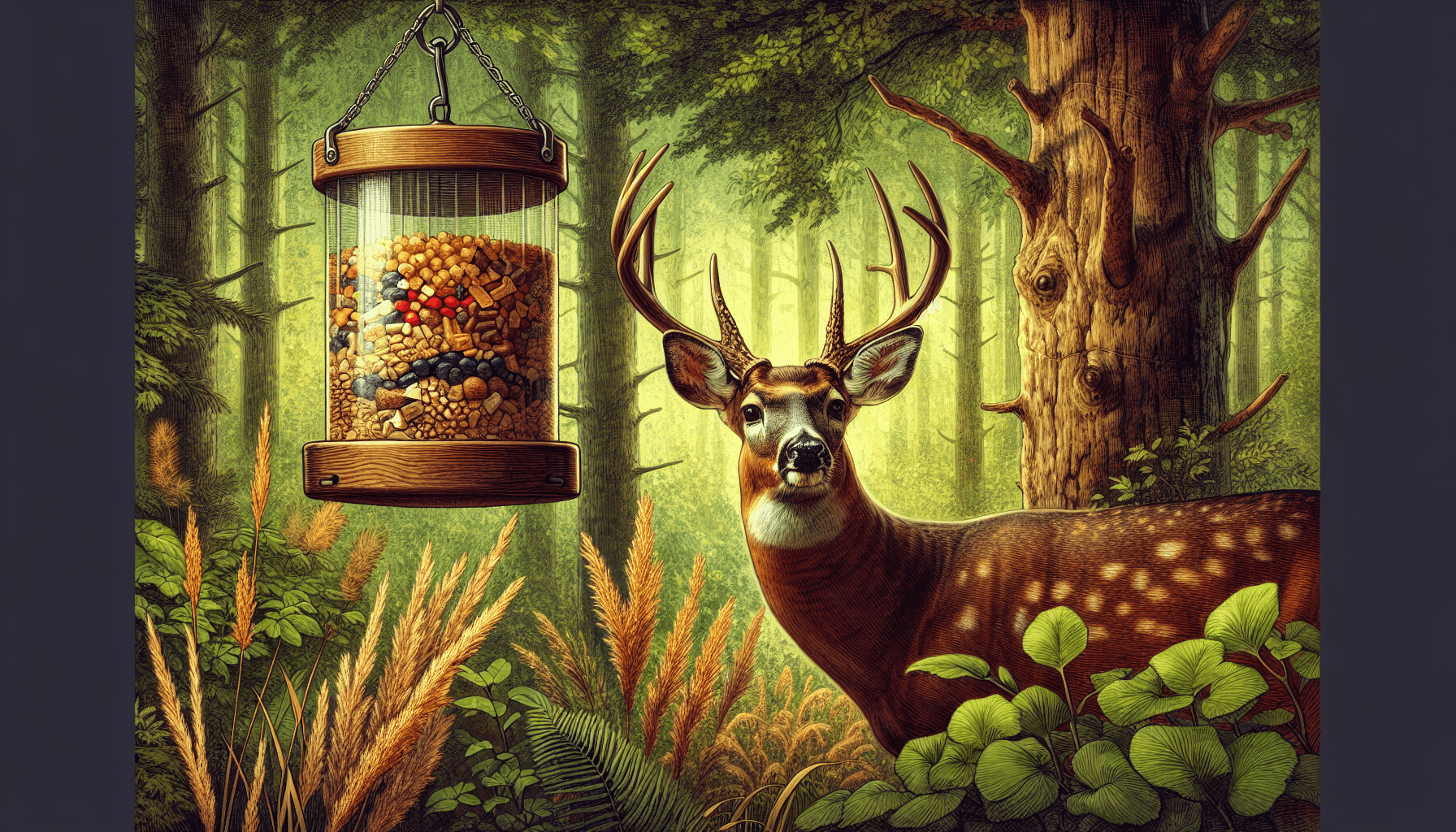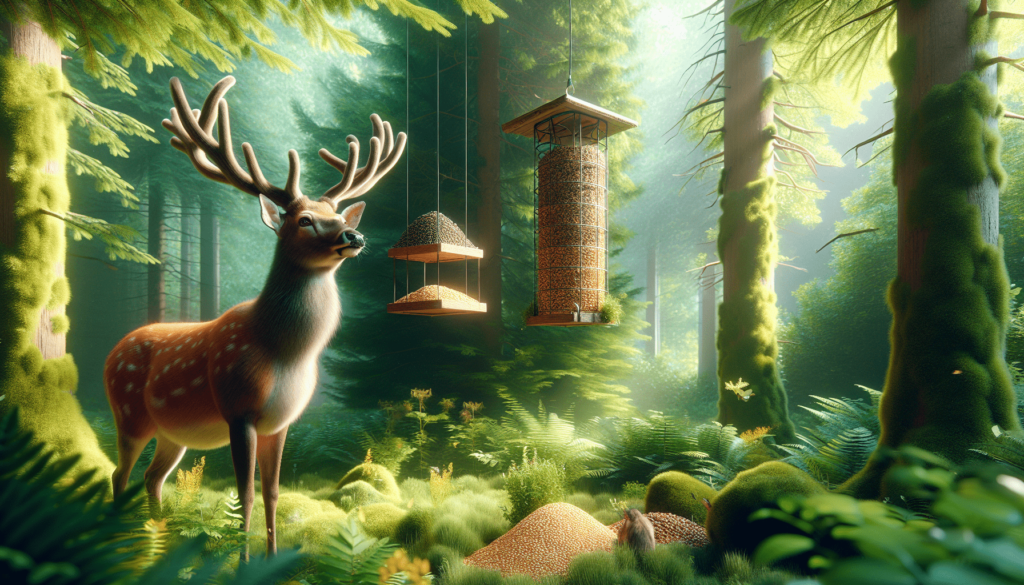
Have you ever wondered how to choose the right feed for your hanging deer feeder? When it comes to supporting local wildlife, particularly deer, selecting the right type of feed can make a significant difference. Whether you own a ranch, manage a wildlife preserve, or just enjoy watching these majestic creatures, feeding deer properly ensures their health and keeps them coming back.

Understanding Deer Nutrition Basics
Deer have specific dietary needs depending on the season and their natural habitat. Generally, their diet consists of herbs, shrubs, grasses, and woody plants. However, when resources become scarce, providing them with supplemental feed can help maintain stable regions and support their overall health.
Seasonal Dietary Needs
In the spring and summer, deer primarily consume greens, including leaves, herbs, and soft shoots. They derive necessary nutrients that promote growth and development. As the seasons change to autumn and winter, their diet shifts to include more woody plants and foliage. This switch is because their natural food sources become less abundant, requiring a nutrient-dense diet to sustain energy and body weight through colder months.
| Season | Primary Diet | Supplement Feed Needs |
|---|---|---|
| Spring/Summer | Leaves, herbs, soft shoots | High-protein, mineral supplements |
| Autumn/Winter | Woody plants, foliage, fallen fruits | High-energy feeds, grains, minerals |
Choosing the Right Feed for Your Hanging Deer Feeder
Selecting the right feed for your hanging deer feeder involves an understanding of nutritional needs and the formulation of available feed types.
Types of Deer Feed
-
Corn – Corn is a common and affordable feed option. It provides a high-energy source but lacks protein and essential nutrients. Use in moderation, especially mixed with other feed types to ensure balanced nutrition.
-
Protein Pellets – These pellets are formulated to promote better health in deer. They usually contain a mix of grains, legumes, and supplements providing a balanced diet, especially beneficial during the growing season.
-
Mineral Supplements – Essential for antler development and overall bone health, mineral supplements like those from Moultrie and Highwild are vital. They often include calcium, phosphorus, and additional trace minerals.
-
High-energy Feeds – These feeds are rich in fats, such as acorns or specially blended feed pellets, to supply energy during winter. Brands like Boss Buck and On Time Wildlife Feeders offer such blends.
Recommended Brands and Their Products
Choosing trusted brands ensures quality and consistency in your deer feed. Here’s a quick overview of some optimal choices:
| Brand | Recommended Product | Benefits |
|---|---|---|
| Moultrie | Premium Deer Feed | Balanced nutrition for all seasons |
| American Hunter | High Protein Pellets | Growth promotion and antler development |
| WILDGAME INNOVATIONS | Acorn Rage | High-energy for winter months |
| SolutionsPatIQ | Mineral Mix | Enhances bone and antler growth |
| Highwild | Protein Feed | General health and growth |
| Boss Buck | Winter Survival Mix | Energy-dense, ideal for winter |
| On Time Wildlife Feeders | Nutrient-rich Blends | Year-round balanced nutrition |
Managing Your Hanging Deer Feeder
Knowing when and how to use your hanging deer feeder can make all the difference in effectively supporting wildlife.
Frequency and Amount of Feeding
Deer feeding strategy requires balance. Overfeeding can disrupt natural foraging patterns and lead to dependency, while underfeeding might not provide necessary support. Here are general guidelines:
- Spring/Summer: Feed in moderation, focusing on high-protein supplements to support growth.
- Autumn/Winter: Increase feed frequency and use high-energy feeds to sustain the deers’ energy levels.
Typically, hanging deer feeders are designed to release small, controlled amounts to prevent waste and overfeeding.
Placement of Feeders
Placement is critical for ensuring deer have easy and safe access to feed. Ideally, position feeders near natural deer trails but away from areas of high human activity or roads to minimize stress and potential collisions. A favored spot might be near a forest edge or a field clearing, sheltered from severe weather conditions.
Maintenance of Your Deer Feeder
Regularly inspecting and maintaining your feeders ensures they function correctly and remain hygienic. Clean the feeder and replace old feed to avoid mold and contaminants. Checking for wear-and-tear or blockages keeps the distribution system working efficiently.
Legal Considerations
It’s imperative to know local regulations about deer feeding. Some areas might have restrictions to prevent overpopulation, disease transmission, or unwarranted human-wildlife interactions. Always familiarize yourself with the legal guidelines to ensure compliance.
Understanding Deer Behavior and Feed Attraction
Deer are intelligent creatures, and understanding their behavior can enhance your feeding strategy’s efficiency.
Feeding Patterns
Deer are crepuscular, meaning they are most active during dawn and dusk. Scheduling feeder activities around these times can attract more wildlife. Observe local deer patterns to tailor feed times specific to your area’s deer population.
Scent and Attractants
Deer are attracted to specific scents. Sweet-smelling feeds or those mimicking natural food sources, like acorns, can entice deer more effectively. Brands like WILDGAME INNOVATIONS specialize in making attractant feeds that can be quite effective.
Safety Measures
Protecting deer from predators and ensuring their safety around feeders is essential. Avoid placing feeders in open areas where deer might feel vulnerable. Additionally, using feeders that deter non-target species, such as raccoons or squirrels, ensures that the feed is consumed by deer and not by invaders.

Troubleshooting Common Feeding Issues
Feeding deer is rewarding, but it comes with its set of challenges. Here’s how to troubleshoot some common issues:
Feed Contamination
Mold and bacteria can proliferate in improperly stored or aged feed. Always store feed in dry, cool environments and keep feeder units clean to prevent contamination.
Feed Theft by Other Animals
Many feeders, including brands like American Hunter and Andee, offer animal-proofing features to maintain feed integrity. Ensuring secure lid mechanisms and efficient designs helps prevent theft from non-target animals.
Attracting Deer to a New Feeder
Introducing a new feeder can sometimes require a bit of patience. Start with small amounts of feed and combine it with natural foraging spots. Gradually increase the quantity to allow deer to become accustomed to the new setup.
Long-Term Deer Feeder Strategy
Developing a long-term strategy for your deer feeder operation involves understanding seasonal needs, maintaining consistent quality, and routinely monitoring deer health.
Year-Round Feeding Schedule
A year-round feed schedule ensures that deer receive necessary nutrients to support their life cycles. Adjusting feed types and amounts with seasonal changes promotes balanced nutrition and healthy deer populations.
Monitoring Deer Health
Regularly observing deer that visit your feeders provides insight into their health. Look for signs of malnutrition, injuries, or illness. Involving local wildlife experts can help in making informed decisions about feeding and potential interventions.
Supporting Local Ecosystems
While supplemental feeding aids deer, it’s vital to consider the broader ecosystem. Avoid overfeeding to prevent Deer from disrupting natural plant regeneration and balance feed supplements with the natural habitat.
Environmental and Ethical Considerations
Feeding deer has environmental and ethical implications. Strive to support natural foraging behaviors alongside supplemental feeding to maintain ecological balance.
Impact on Local Flora
Supplemental feeding can lead to overbrowsing if mismanaged. Balance feeder usage with efforts to preserve natural flora by rotating feeding spots and monitoring vegetation health.
Ethical Wildlife Feeding Practices
Develop ethical practices by focusing on enhancing the deer’s natural diet rather than overriding it. Collaborating with wildlife management authorities helps ensure that feeding practices benefit deer without causing environmental harm.
Non-Target Species Management
Preventing non-target species like raccoons, rodents, and even large predators from accessing feeders ensures that deer-specific feed is not diverted. Specific feeder designs by brands like SolutionsPatIQ and KUMFJ help manage these challenges effectively.
Conclusion
Understanding how to choose the right feed for your hanging deer feeder involves a combination of nutritional knowledge, appropriate product selection, and responsible feeding practices. Whether you’re using feeds from Moultrie, American Hunter, or any other reputable brands, remember to feed wisely, consider deer health, ecosystem balance, and comply with local regulations. With thoughtful consideration and careful management, you can create a beneficial and sustainable feeding program that supports vibrant and healthy deer populations.
Keep observing and adjusting your strategy based on the unique needs of your local deer to ensure they thrive year-round.



